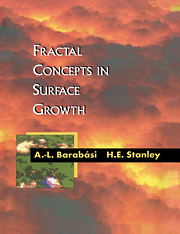Book contents
- Frontmatter
- Contents
- Preface
- Notation guide
- PART 1 Introduction
- 1 Interfaces in nature
- 2 Scaling concepts
- 3 Fractal concepts
- PART 2 Nonequilibrium roughening
- PART 3 Interfaces in random media
- PART 4 Molecular beam epitaxy
- PART 5 Noise
- PART 6 Advanced topics
- PART 7 Finale
- APPENDIX A Numerical recipes
- APPENDIX B Dynamic renormalization group
- APPENDIX C Hamiltonian description
- Bibliography
- Index
3 - Fractal concepts
Published online by Cambridge University Press: 23 December 2009
- Frontmatter
- Contents
- Preface
- Notation guide
- PART 1 Introduction
- 1 Interfaces in nature
- 2 Scaling concepts
- 3 Fractal concepts
- PART 2 Nonequilibrium roughening
- PART 3 Interfaces in random media
- PART 4 Molecular beam epitaxy
- PART 5 Noise
- PART 6 Advanced topics
- PART 7 Finale
- APPENDIX A Numerical recipes
- APPENDIX B Dynamic renormalization group
- APPENDIX C Hamiltonian description
- Bibliography
- Index
Summary
In the previous chapter, we introduced a simple growth model that exhibits generic scaling behavior. In particular, the interface width w increases as a power of time [Eq. (2.4)], and the saturated roughness displays a power law dependence on the system size [Eq. (2.5)]. There exists a natural language for describing and interpreting such scaling behavior, and this is the language of fractals. In this chapter, we introduce the concepts of fractal geometry, which provide a language in terms of which to better understand the meaning of power laws. Isotropic fractals are self-similar: they are invariant under isotropic scale transformations. In contrast, surfaces are generally invariant under anisotropic transformations, and belong to the broader class of self-affine fractals. We will therefore also discuss the basic properties of self-affine fractals, as well as numerical methods for calculating the critical exponents α, β, and z.
Self-similarity
An object can be self-similar if it is formed by parts that are ‘similar’ to the whole. One of the simplest self-similar objects is the Cantor set, whose iterative construction at successive ‘generations’ is shown in Fig. 3.1. If we enlarge the box of generation 3 by a factor of three, we obtain a set of intervals that is identical to the generation 2 object. In general, at generation k we can enlarge part of the object by a factor of three and obtain the object of generation (k – 1).
- Type
- Chapter
- Information
- Fractal Concepts in Surface Growth , pp. 29 - 37Publisher: Cambridge University PressPrint publication year: 1995
- 2
- Cited by



